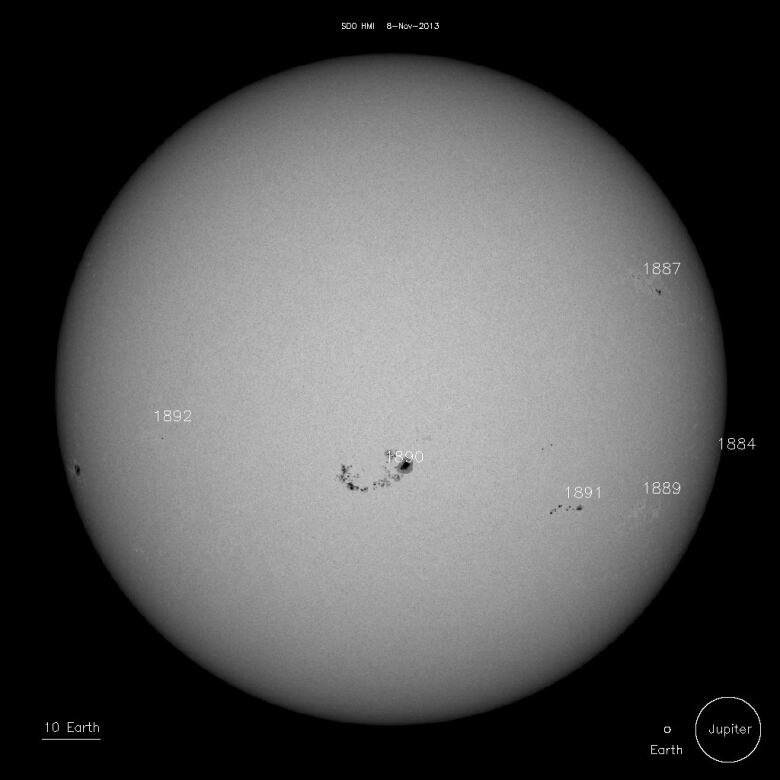Sun's pending magnetic flip has physicists on edge
Solar flares abound as peak of magnetic cycle approaches

The Suns magnetic field will soon make a dramatic flip, which it does every 10 to 13 years, and scientists are keeping a close eye to see if that reverses the bizarre behaviour theyve been seeing for the past decade.
Last week, the sun unleashed the biggest solar flare of the year, anX3.3 flare, which was followed with an only slightly less intense X1 flare from a Jupiter-sized sunspot.
X-class flares are the most powerful class of solar flares, and in late Octoberthe sun firedoff four in the space of a week.
All indications suggest the sun isrampingup to the midpoint of its solar cycle which is the peak moment at which it is expected to reverse its magnetic field.
We would feel happier if we saw the sun doing business as usual.- Ken Tapping, National Research Council of Canada
The sun has been behaving particularly strangely since the last time its magnetic field flipped in 2003.
So solar physicists such as Ken Tapping at the National Research Council of Canada are watching carefully.
As you can imagine, were concerned about whats going to happen next, saidTapping, who leads a team that monitors the suns magnetic activity using a radio telescope in Penticton, B.C.
Obviously, we would feel happier if we saw the sun doing business as usual, rather than heading off into some territory where we basically are not sure we understand whats going to happen.
A 'sphere' of gas
The suns magnetic field is produced by the movement of hot gases as it rotates and as heat rises from the suns core to its surface.
Tapping says the magnetic field is what makes the sun appear like a solid sphere rather than a transparent ball of gas: "It changes the fuzzy blob into something thats more like a block of rubber."

The effects of thismagnetic field extend far beyond the planets of the solar system to the edge of interstellar space.
The polarity of the suns magnetic field flips every 10 to 13 years, an average of 11 years, marking the peak and midpoint of each solar cycle. The most recent cycle,Solar Cycle 24, started in 2008 and is now approaching its midpoint.
According to NASA, the next flip is expected by the end of the year.
Tapping says the eventtypically takes one to a few months, and can be observed via the strength of the magnetic field over the suns surface something that the Penticton measurements help calculate.
The beginning of the flipis also marked by the appearance of sunspots at high solar latitudes that are "magnetically the other way round"compared to those at the sun's equator, Tapping said.
Sunspots typically form close to the "poles"of the sun at the beginning of a solar cycle, and gradually move toward the equator over the course of the cycle. The cycles overlap so that sunspots from two cycles typically coexist for a period of time.
Temporary increase in solar flares
Tapping added that the flip will probably have little effect on us humans, other than temporarily increasing the chance of significant solar flares.
I think that will give us an indication of whether the sun will sit there smouldering or whether it's going to come back to usual behaviour.- Ken Tapping, National Research Council of Canada
Solar flares areeruptions of magnetic energy from the suns surface.
If they are directed toward Earth, they can interact with the Earth's magnetic field,knocking outman-made satellites and power grids, affecting navigation equipmenton airplanes, and interferingwith other electronics and communications systems.
The potential damage to electronic infrastructure on and around Earth isone of the main reasons scientists keep such a close eye on the suns magnetic activity.
Around the solar cycle peak and magnetic flip of 2003, the midpoint of Solar Cycle 23, the sun blasted off 17 major eruptions over the space of three weeks, including a record-setting X28 flare.
The resulting geomagnetic storms generated blood-red auroras on Halloween and partially disabled half of NASA's satellite fleet, permanently damaging some satellites.
The rise inpowerful solar flaresat the peak of asolar cycle isdue tothe increased complexity of the suns magnetic field as it preparesto flip.
Start of strange behaviour
While this year's solar storms are far weaker than the ones in 2003, they are "a bigger surprise even as they do less damage," NASA says, since they come at the peak of one of the weakest solar cycles in a century.
The 2003 magnetic flip markedthe beginning of some unexpected behaviour. The relationship between two measurements of the suns magnetic activity that normally correspond the magnetic field strengthand sunspot counts started to diverge.
The next solar cycle was supposed to start in 2008, but "things just sat,"Tapping said. "And then the next cycle was about two years late in starting."
Since then, it has been a cycle of unusually low magnetic activity.
"When we see the flip and start to get an idea of how activity starts to build up for the next cycle,"Tapping said, "I think that will give us an indication of whether the sun will sit there smouldering or whether it's going to come back to usual behaviour."
He noted, however, that usual behaviouris relative term, since scientists have only been monitoring sunspots since the 1700s, and taking more comprehensive measurements of the 4.5-billion-year-old sun since the mid-20th century.
"In all probability,"Tapping added. "The sun has done this before."












_(720p).jpg)


 OFFICIAL HD MUSIC VIDEO.jpg)
.jpg)



























































































